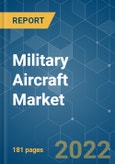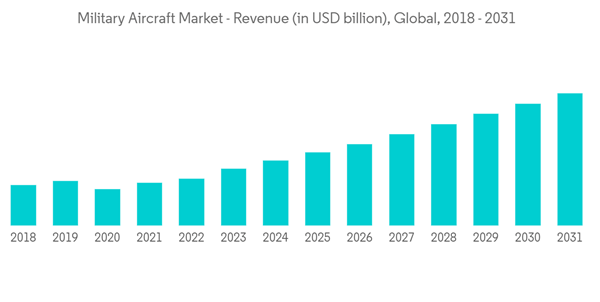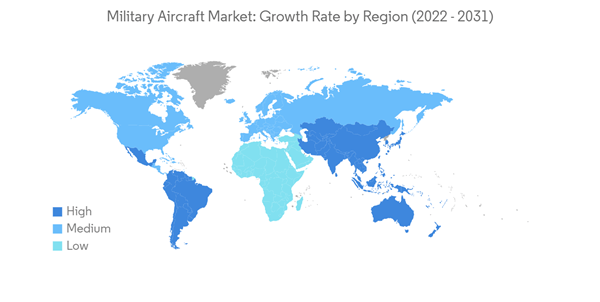The military aircraft market was valued at USD 96.24 billion in 2021, and it is projected to register a CAGR of over 4% during the forecast period (2022-2031).
The COVID-19 outbreak impacted the supply chain of certain aircraft programs, which resulted in delivery delays in 2020. However, the situation improved in 2021 for several military aircraft manufacturers worldwide. On the other hand, no visible impact was noted on the orders placed by various armed forces worldwide. Certain countries that were already struggling with weak economies before the pandemic felt the impact of COVID-19. According to the Stockholm International Peace Research Institute (SIPRI), defense expenditure in 2020 reached USD 1,981 billion, an increase of 2.6% in real terms from 2019.
Political conflicts and territorial disputes continue to fuel the demand for advanced military aircraft with multi-mission capabilities. Also, several countries are looking to modernize their fleets by replacing older models with newer generation aircraft that require less maintenance and have lower operating costs.
Numerous countries are focusing on reducing the reliance on foreign vendors for their military platforms and equipment. Also, the high costs involved in acquiring foreign aircraft are forcing several developing countries to embark on their military aircraft development programs. On the other hand, players are also focusing on localized manufacturing of military aircraft and enhancing their indigenous platform development capabilities through technology transfer agreements.
As tensions between various global nations have increased, countries are striving to enhance their aerial combat capabilities. Several nations have upgraded their fighter jets or replaced their aging fleet with newer-generation aircraft with advanced features. With the growth in defense spending by several countries worldwide, the industry witnessed large-scale procurement and development activities for fighter jets in the last few years. Technology advancements in stealth and precision weapons have further supported the development of the fighter aircraft market, as each country wants its combat capabilities to be up-to-date. The focus is slowly shifting toward the era of fifth- and sixth-generation fighter jets. However, apart from a very few countries globally, several countries do not have fifth-generation fighters at their disposal. Hence, the development and procurement of fifth-generation fighters are expected to increase during the forecast period. Players from North America and Europe have dominated the fighter aircraft industry over the years. However, players from Asia-Pacific have been rapidly developing their fighter aircraft manufacturing capabilities. They are expected to provide tough competition to the established players from the other regions in the coming years. For instance, in April 2021, Korea unveiled the first prototype of the KF-21 fighter aircraft developed in partnership with Indonesia. The aircraft was officially given the name Boramae. The first test flight is anticipated in 2022, with manufacturing scheduled to begin in 2026. Such developments are expected to drive the market's growth in the coming years.
Over the past few years, there has been a growing demand for new military aircraft from the Asia-Pacific region as major countries look to modernize their fleet and increase their capabilities. In July 2021, the Australian Army received the first two of the four new Boeing CH-47F Chinook transport helicopters. The contract is worth USD 441 million and will increase the army's fleet of heavy-lift CH-47Fs to 14. The third and fourth helicopters are scheduled for delivery in mid-2022. The Royal Australian Air Force (RAAF) also ordered two more P-8As, bringing its number of P-8As under contract to 14. The P-8As are land-based anti-submarine and anti-surface ship jets designed for intelligence, surveillance, and reconnaissance missions. The P-8s are also operated by the Indian Navy, Royal New Zealand Air Force, and the Republic of Korea Navy. In September 2021, the Indian government approved a procurement request for 56 C295 transport aircraft from Airbus Defence and Space in Spain, under which 40 military planes will be manufactured in India by the local firm Tata Group. India is currently taking the deliveries of Rafale Jets from France as part of a deal signed in 2016. A total of 36 jets were ordered, with deliveries expected to be completed by April 2022. China has also inducted several new military aircraft into its fleet over the past five years. Such procurements may result in Asia-Pacific recording the highest CAGR during the forecast period.
The military aircraft market is highly fragmented due to the presence of many players that offer several types of aircraft. Lockheed Martin Corporation, The Boeing Company, Textron Inc., Rostec, and Airbus SE are some of the prominent players in the military aircraft market. The companies' increased investments in the development of new and advanced aircraft have been helping them maintain their market positions. For instance, HAL is developing a fifth-generation fighter aircraft under the Advanced Medium Combat Aircraft (AMCA) program. Northrop Grumman is developing the B-21 Raider with a unique design and structure. The development of such new aircraft may generate demand from the armed forces worldwide. Companies, in collaboration with governments, are investing in the development of new-generation special mission and maritime patrol aircraft equipped with the modern surface ship and submarine detection systems and combat ability. The development of such advanced aircraft with advanced surveillance and reconnaissance, along with anti-submarine warfare and anti-ship warfare capabilities, is expected to strengthen the presence of players in the market in the coming years.
This product will be delivered within 2 business days.
The COVID-19 outbreak impacted the supply chain of certain aircraft programs, which resulted in delivery delays in 2020. However, the situation improved in 2021 for several military aircraft manufacturers worldwide. On the other hand, no visible impact was noted on the orders placed by various armed forces worldwide. Certain countries that were already struggling with weak economies before the pandemic felt the impact of COVID-19. According to the Stockholm International Peace Research Institute (SIPRI), defense expenditure in 2020 reached USD 1,981 billion, an increase of 2.6% in real terms from 2019.
Political conflicts and territorial disputes continue to fuel the demand for advanced military aircraft with multi-mission capabilities. Also, several countries are looking to modernize their fleets by replacing older models with newer generation aircraft that require less maintenance and have lower operating costs.
Numerous countries are focusing on reducing the reliance on foreign vendors for their military platforms and equipment. Also, the high costs involved in acquiring foreign aircraft are forcing several developing countries to embark on their military aircraft development programs. On the other hand, players are also focusing on localized manufacturing of military aircraft and enhancing their indigenous platform development capabilities through technology transfer agreements.
Key Market Trends
Revenues from the Fighter Aircraft Segment Dominated the Market in 2021
As tensions between various global nations have increased, countries are striving to enhance their aerial combat capabilities. Several nations have upgraded their fighter jets or replaced their aging fleet with newer-generation aircraft with advanced features. With the growth in defense spending by several countries worldwide, the industry witnessed large-scale procurement and development activities for fighter jets in the last few years. Technology advancements in stealth and precision weapons have further supported the development of the fighter aircraft market, as each country wants its combat capabilities to be up-to-date. The focus is slowly shifting toward the era of fifth- and sixth-generation fighter jets. However, apart from a very few countries globally, several countries do not have fifth-generation fighters at their disposal. Hence, the development and procurement of fifth-generation fighters are expected to increase during the forecast period. Players from North America and Europe have dominated the fighter aircraft industry over the years. However, players from Asia-Pacific have been rapidly developing their fighter aircraft manufacturing capabilities. They are expected to provide tough competition to the established players from the other regions in the coming years. For instance, in April 2021, Korea unveiled the first prototype of the KF-21 fighter aircraft developed in partnership with Indonesia. The aircraft was officially given the name Boramae. The first test flight is anticipated in 2022, with manufacturing scheduled to begin in 2026. Such developments are expected to drive the market's growth in the coming years.
Asia-Pacific is Expected to Experience the Highest Growth During the Forecast Period
Over the past few years, there has been a growing demand for new military aircraft from the Asia-Pacific region as major countries look to modernize their fleet and increase their capabilities. In July 2021, the Australian Army received the first two of the four new Boeing CH-47F Chinook transport helicopters. The contract is worth USD 441 million and will increase the army's fleet of heavy-lift CH-47Fs to 14. The third and fourth helicopters are scheduled for delivery in mid-2022. The Royal Australian Air Force (RAAF) also ordered two more P-8As, bringing its number of P-8As under contract to 14. The P-8As are land-based anti-submarine and anti-surface ship jets designed for intelligence, surveillance, and reconnaissance missions. The P-8s are also operated by the Indian Navy, Royal New Zealand Air Force, and the Republic of Korea Navy. In September 2021, the Indian government approved a procurement request for 56 C295 transport aircraft from Airbus Defence and Space in Spain, under which 40 military planes will be manufactured in India by the local firm Tata Group. India is currently taking the deliveries of Rafale Jets from France as part of a deal signed in 2016. A total of 36 jets were ordered, with deliveries expected to be completed by April 2022. China has also inducted several new military aircraft into its fleet over the past five years. Such procurements may result in Asia-Pacific recording the highest CAGR during the forecast period.
Competitive Landscape
The military aircraft market is highly fragmented due to the presence of many players that offer several types of aircraft. Lockheed Martin Corporation, The Boeing Company, Textron Inc., Rostec, and Airbus SE are some of the prominent players in the military aircraft market. The companies' increased investments in the development of new and advanced aircraft have been helping them maintain their market positions. For instance, HAL is developing a fifth-generation fighter aircraft under the Advanced Medium Combat Aircraft (AMCA) program. Northrop Grumman is developing the B-21 Raider with a unique design and structure. The development of such new aircraft may generate demand from the armed forces worldwide. Companies, in collaboration with governments, are investing in the development of new-generation special mission and maritime patrol aircraft equipped with the modern surface ship and submarine detection systems and combat ability. The development of such advanced aircraft with advanced surveillance and reconnaissance, along with anti-submarine warfare and anti-ship warfare capabilities, is expected to strengthen the presence of players in the market in the coming years.
Additional Benefits:
- The market estimate (ME) sheet in Excel format
- 3 months of analyst support
This product will be delivered within 2 business days.
Table of Contents
1 INTRODUCTION
3 EXECUTIVE SUMMARY
4 MARKET DYNAMICS
5 MARKET SEGMENTATION (Market Size and Forecast by Value - USD billion, 2018 - 2031)
6 COMPETITIVE LANDSCAPE
Companies Mentioned (Partial List)
A selection of companies mentioned in this report includes, but is not limited to:
- Lockheed Martin Corporation
- The Boeing Company
- Northrop Grumman Corporation
- Saab AB
- BAE Systems PLC
- Rostec
- Hindustan Aeronautics Limited
- AVIC
- Korea Aerospace Industries
- Mitsubishi Heavy Industries Ltd
- Leonardo SpA
- Textron Inc.
- Airbus SE
- Dassault Aviation
- Piper Aircraft Inc.
Methodology

LOADING...










